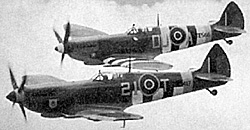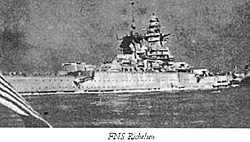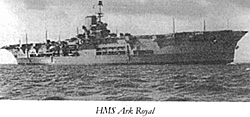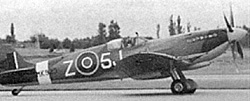
Background for a SEEKRIEG Campaign, the lead-up to SEELÖWE, (Operation SEALION), the German invasion of Britain. The information in both of these articles is based entirely on fact. Several assumptions were made, and conclusions drawn from them, to provide an alternate reality, in order to make the campaign viable.
"OUR FINEST HOUR!"
Mr. Churchill Addresses Commons
- In the aftermath of the withdrawal from
Dunkirk, the Prime Minister has assured the House of
Commons that Britain will go on, and stand, alone if
necessary, against Nazi Germany and their allies.
Prime Minister Churchill spoke to a packed
Commons: "The Battle of France is now over. I expect the
Battle of Britain is about to begin... Let us therefore brace
ourselves to our duties, and so bear ourselves that, if the
British Empire and it's Commonwealth last for a thousand
years, men will say, 'This was their finest hour!'
--The Times, June 19, 1940
At the beginning of the Battle of France, as it became known, the RAF committed 400 of it's fighters and bombers to the front line. Part of this was a group called the Advanced Air Striking Force, consisted of six squadrons of Hawker Hurricanes, and two squadrons of (obsolete) Gloster Gladiators, a total of 128 fighter aircraft. The remainder was made up of light bombers, the (obsolete) Fairey Battle, and the more modern Bristol Blenheim, neither of which stood much of a chance against a German fighter.
Losses amongst these aircrews were devastating: in the first five days of battle, from May 10 to 15, 205 aircraft of the AASF were lost, the majority being bombers. This served to prove one point: that obsolete aircraft had no place in air combat, as they simply served as 'flying coffins' for their crews.
The C-in-C of Britain's Fighter Command, Air Chief Marshal Sir Hugh Dowding, believed that to defend Britain, he needed to build up a force of fifty-two squadrons of front-line fighters. With the forces deployed in France, the number available was well below that requirement. On May 12, four more squadrons (sixty-four aircraft) were despatched to France. The next day , two more squadrons joined them.
On May 15, with the situation in France becoming steadily worse for the RAF, Dowding went to 10 Downing Street, and met with Prime Minister Churchill, Air Minister Sinclair, the newly created Minister of Aircraft Production, Lord Beaverbrook, and the Chief of Air Staff, Sir Cyril Newall, to explain the situation. He in formed them that the RAF could not support the losses which it was suffering and still be able to defend the country.
The following day, Churchill flew across to Paris, and met with M. Reynaud, the French President. After hearing Reynaud's desperate plea for more assistance, Churchill telephoned London, and asked cabinet to sent six more squadrons of Hurricanes to defend France. They compromised, sending the six squadrons to operate from forward airfields in France by day, returning to England each night.
Dowding's effective defence force was now down to twenty-six squadrons: exactly half of what was needed for Britain's defence. But more were to go; Churchill ordered four more squadrons to France at the next Cabinet meeting, later claiming that Dowding told him that only twenty-five squadrons were needed for the defence of Great Britain.
On or about June 12, the Minister of Marine, and C-in- C of the French armed forces, Admiral Darlan, had assured both British and American envoys that under no circumstances would any of the French fleet fall into German hands, "no matter what the consequences". Under Article 8 of the armistice terms, the French fleet, other than their Colonial defence vessels, was to be recalled to French territorial waters, and be assembled in harbours yet to be specified, there to be demobilised and or disarmed, under German or Italian control.
On June 17 1940, Marshal Petain formed the government of Occupied France, (or Vichy France as it became known) following the resignation of M. Reynaud. He immediately sought an armistice from the Germans, and he received their conditions on June 21.
FRANCE DEFEATED?
MARSHAL PETAIN TO FORM NEW GOVERNMENT
- June 17, Vichy, France: Marshal Phillippe
Petain has addressed the citizens of
conquered France, telling them that he has
sought an armistice with the Germans. The
President, M. Lebrun had just asked him to
form a new government, to lead France
through its most trying time.
--New York Times, June 19, 1940
The British reaction was one of panic, and plans were made to seize the French vessels in British ports, and to attack the French fleet (which had fled to the French North African ports), in order to prevent them surrendering to the Germans.
Admiral Darlan urged M. Petain not to accept the armistice under this condition, but his loud opposition merely served to upset Petain, who sacked him, replacing him with M. Laval, the former Vice President. It was suggested that this was done out of fear that the Germans would impose harsher terms on the armistice.
On June 23, the British Ambassador and his staff left Bordeaux, and returned to England, cutting off all communications between the governments of the two nations.
On June 26, M. Laval ordered Admiral Darlan (who was still the C-in-C of the fleet), to recall the fleet to the French Atlantic ports. Darlan objected strongly, and suggested that the fleet should sail for America, as he did not trust the Germans. His attitude only served to have him removed from his post, and the order to recall the fleet was sent.
The armistice was signed on June 30, France formally agreeing to disarm their fleet in their Atlantic ports. On June 28, the British despatched Vice- Admiral Sir James Somerville in command of Force H - the battlecruiser HMS Hood, the battleships HMS Resolution and Valiant, the carrier HMS Ark Royal, two cruisers and eleven destroyers - to prevent the French from leaving their North African bases.
The French squadron at Alexandria (under the command of Vice-Admiral Godfroy) sailed early on June 28, barely three hours before the commander of the British Eastern Mediterranean Fleet, Admiral Cunningham, received orders to prevent their departure, "by whatever means necessary".
In the early hours of July 1, the British seized the French ships lying in Portsmouth and Plymouth harbours - the pre-war battleships FNS Courbet and Paris, eight modern destroyers, several smaller craft, and three submarines, including the unusual 'cruiser submarine' FNS Surcouf, with it's twin eight-inch gun armament.
One French officer was killed, and two British officers wounded during the action. The crews were offered a chance to join the Free French Navy, those declining were interned as POWs, on the Isle of Man. This action caused a rift between the two navies, and great animosity, which may have been influential in the actions following year.
 Force H arrived off Gibraltar on July 1, as the
French fleet was preparing to leave the Mediterranean.
Returning to France were the battlecruisers FNS Strasbourg (at right)
and Dunkerque, the battleships FNS Provence, Bretagne,
Lorraine, Richelieu, the incomplete Jean Bart, the carriers FNS
Bearn and Commandant Teste, along with ten cruisers, over
twenty destroyers, and many smaller escorts and
submarines.
Force H arrived off Gibraltar on July 1, as the
French fleet was preparing to leave the Mediterranean.
Returning to France were the battlecruisers FNS Strasbourg (at right)
and Dunkerque, the battleships FNS Provence, Bretagne,
Lorraine, Richelieu, the incomplete Jean Bart, the carriers FNS
Bearn and Commandant Teste, along with ten cruisers, over
twenty destroyers, and many smaller escorts and
submarines.
Unsure of what to do, and unwilling to order an attack on such a formidable force, Somerville could only watch as the vast fleet assembled off Tangier, and sailed for France.
 Richelieu
Richelieu
When Churchill learned that the fleet had returned to France, he ordered that they should be attacked in their ports by aircraft from HMS Ark Royal and Illustrious, so as to prevent any French warship from threatening England's security.
BRITISH SEIZE BATTLESHIPS!
NO HANDOVER TO NAZIS SAYS P.M. CHURCHILL
- French warships lying in Plymouth and Portsmith harbours were seized in an
operation in the early hours of July First. The operation was necessary to prevent the
ships returning to France, where the Germans could capture them and use them against the Royal Navy.
A spokesman said that no casualties were suffered during the action, and that all the crews were co-operative.
A War Ministry spokesman says that the remaining French fleet poses no threat to the United Kingdom, and that the Royal navy is
still the dominant force on the world's oceans.
--The Times, July 8, 1940
On July 10, in an attack similar to the one that would later prove so effective at Taranto, though on a larger scale, and with less careful pre-planning, eighty-five of the Royal Navy's Swordfish torpedo bombers were sent to attack the three ports where the majority of the French ships were moored.
 Forty-seven aircraft, from HMS Ark Royal, attacked
Brest, where FNS Richelieu, Strasbourg and Dunkerque were
anchored, with six cr uisers and over forty submarines. All
the ships were well protected by torpedo nets, and as a result,
of the thirty-one torpedoes launched by the aircraft, only
two reached their intended target, striking the FNS
Dunkerque amidships. Both torpedoes failed to detonate.
Forty-seven aircraft, from HMS Ark Royal, attacked
Brest, where FNS Richelieu, Strasbourg and Dunkerque were
anchored, with six cr uisers and over forty submarines. All
the ships were well protected by torpedo nets, and as a result,
of the thirty-one torpedoes launched by the aircraft, only
two reached their intended target, striking the FNS
Dunkerque amidships. Both torpedoes failed to detonate.
Two submarines and one destroyer-escort were sunk by errant torpedoes. Of the remaining aircraft, eight bomb armed Swordfish managed to score eleven hits from medium altitude, none of which caused any significant damage to the capital ships, though the cruisers FNS Suffren and Georges Leygues were both damaged, the former spending over two months under repair, the latter in dry dock for seven weeks. The other eight aircraft were shot down before making their attacks. Seventeen men of those aircrews survived to be taken prisoner.
At Lorient, the targets for the twenty-six torpedo armed Swordfish from HMS Illustrious were the pre-WWI battleships FNS Provence, Bretagne and Lorraine. Twenty of the planes survived the storm of anti-aircraft fire to make their attacks, seven torpedoes finding their way through the nets protecting the vessels. FNS Provence was hit twice, but only one of the torpedoes detonated, seriously damaging her rudders. T hree torpedoes failed to detonate against the hull of the FNS Lorraine, but both of the torpedoes which struck FNS Bretagne detonated, damaging her bows, and causing severe flooding. Both ships spent several months being repaired, FNS Bretagne having to be towed to dry dock at St. Nazaire.
The attack on the FNS Jean Bart, and the seaplane carrier FNS Commandant Teste at St. Nazaire took place almost an hour later, by twelve Swordfish, also from HMS Illustrious. They were intercepted by fifteen aircraft from the carrier, the local commander having been informed of the action at Lorient, and taking preventative measures. Five of the attackers made it to within sight of the ships, before they were shot down by fierce anti-aircraft fire from the port batteries and the ships themselves. Out of thirty-six crew, only seven survived what would be later termed "...an ill-planned, poorly-executed, badly-timed, suicidal charge...".
RAF Losses
 When France fell on June 22, the RAF had lost 959
aircraft in the West, and 66 in the Norwegian Campaign, 509
of these being fighter 'planes (only 66 of 261 Hurricanes
returned from France). Worse still, they had lost 435 pilots,
killed, missing or captured. The situation for home defence
seemed almost hopeless, as the Luftwaffe closed in.
When France fell on June 22, the RAF had lost 959
aircraft in the West, and 66 in the Norwegian Campaign, 509
of these being fighter 'planes (only 66 of 261 Hurricanes
returned from France). Worse still, they had lost 435 pilots,
killed, missing or captured. The situation for home defence
seemed almost hopeless, as the Luftwaffe closed in.
On July 1, the RAF had 591 serviceable fighters, only 160 of them being Spitfires. There were 1200 trained pilots in the RAF Fighter Command. By comparison, on July 20 (the earliest available accurate figure) the Luftwaffe had 856 first line fighters, 656 of them being the technically superior (and much better armed) Messerschmitt 109, the remainder being the twin engined Me 110.
 The major danger for the RAF was not running out
of aircraft, as the production of new aircraft was averaging
over 450 per month, but running out of trained pilots. RAF
training was producing about 200 pilots per month in 1939,
and the program was slow to expand as the war progressed:
this compared to the Luftwaffe 'training machine', which
produced 800 pilots per month, and had been doing so for years.
The major danger for the RAF was not running out
of aircraft, as the production of new aircraft was averaging
over 450 per month, but running out of trained pilots. RAF
training was producing about 200 pilots per month in 1939,
and the program was slow to expand as the war progressed:
this compared to the Luftwaffe 'training machine', which
produced 800 pilots per month, and had been doing so for years.
It took many weeks to properly train a pilot, then several combat missions before they were no longer considered 'green'. Even pilots transferred into Fighter Command from the other wings (Bomber Command, Coastal Command and the Fleet Air Arm) needed six weeks of training and familiarisation, before they were considered ready to go into combat. This training period was halved in August, when the shortage of pilots became critical.
The first phase of the Battle of Britain began at the start of July 1940. This phase was called Kanalkampf (channel war) by the Germans. It involved strafing and bombing attacks on British shipping in the English Channel. It was a win-win situation for the Germany. If the RAF did nothing to defend the ships, then merchant losses would become dangerously high; if the RAF flew to intercept the attackers, they would be drawn into a battle of attrition with a numerically superior enemy, a situation that Air Chief Marshal Dowding was keen to avoid.
By July 19, the situation was so serious, that it appeared as though Fighter Command would be totally destroyed within six weeks, if the current level of losses continued. By the end of July, Dowding had lost 118 aircraft, which were immediately replaced, but he had also lost eighty of his experienced squadron and flight commanders, losses which were devastating to both morale, and to the ability of the RAF to continue the fight. Göring's Luftwaffe had suffered major losses as well, but these were more easily replaced, because of their larger cadre of experienced crews, and their greater training output.
Throughout July, the Luftwaffe had gradually begun to grasp the importance of the massive radio towers which ringed the coastline of Britain. It was these Radar towers which allowed the British to know in advance about raids, and to thus direct their fighters to intercept them. The Germans had believed that defences were locally directed, and it took them some time to realise that the whole system operated as a centrally controlled network. It was decided that something must be done to attempt to disable this early warning system, in order to finish off the RAF.
On August 1, Hitler's Fuhrerdirectiv 17 granted the Luftwaffe's Commander in Chief, Reichsmarschall Herman Göring, the authority to launch a major air offensive against Britain itself, targeting RAF airfields, industrial targets, ports and shipping, at any time after August 5. The date selected was August 13, referred to as Adlertag, 'Eagle Day'.
The offensive was called 'Eagle Attack', or:
ADLERANGRIFF!
- Der Britsches Heer und RAF ist Kaput Kanalkampf aus der Luftwaffe Britisches ine zerstor Adlertag aus der sieg!
--from 'SIGNAL' magazine, September 1940
The follow up attacks by the Ju 87 dive- bombers of Stukageschwader 1 hit the airfields at Hawkinge and Lympne, damaging both fields badly, without any of the bombers being lost.
After this attack came almost 100 Ju 88s, of Kampfgeschwader 51, which made an attack on Portsmouth docks, and shipping. Fifteen of the Ju 88s veered off, and bombed the radar station at Ventnor, damaging it so badly that it was off the air for three days.
In the twelve days which followed, the Germans made many more attacks, varying in size and in target, bombing fighter airfields, radar stations, shipping and coastal cities and towns. During this period, Fighter Command lost over ninety pilots killed, and fifty wounded, many so badly that they would never be able to fly again. This terrible trend was to continue, though never again on the same scale.
French Navy Under Germany
Just after one o'clock on the morning of August 13, in a carefully coordinated action, heavily armed parties stormed aboard all the Vichy French ships anchored in the occupied ports, where they were preparing to be disarmed and demobilised as per the terms of the armistice (about forty-five percent of the ships were still crewed, though they were only skeleton crews, unable to effectively resist the boarding parties).
This action was ordered by Hitler at the suggestion of Grand Admiral Raeder, the C-in-C of the German Kriegsmarine. In seizing the French fleet, Raeder planned to open a new avenue to the Atlantic, which would force the Royal Navy to spread themselves more widely, if they were to prevent Britain being strangled.
By the middle of October the Germans had re-mobilised almost all of their prizes, some totally re-crewed, others with volunteer French crews serving alongside their conquerors. The FNS Jean Bart was commencing her sea-trials, having been completed on October 3, to match her sister FNS Richelieu, as planned before the invasion of six months previous.
Formerly French coastal patrol craft and submarines were at sea as early as September 16, adding to the dangers facing merchant ships in the waters around Great Britain and Ireland.
To add to the headache for the Royal Navy, two days after the FNS Jean Bart was sighted on manoeuvres, seven cruisers left port, in company with nine destroyers, two supply ships and three oilers. Amongst the cruisers were the eight-inch armed FNS Colbert and Algerie. With this armada of fast raiding ships in the North Atlantic, no convoy would be safe, escorted or otherwise.
New Air Phase
On August 24, a new phase of the battle developed. The Luftwaffe concentrated all their attacks on fighter airfields and industrial targets, in an attempt to draw the RAF into battle. It worked. The raids wrecked airfields, and the large, well escorted bomber formations were more than a match for the British, except when the RAF could muster enough squadrons in the right place at the right time, in which case, the tables could be turned. The German bombers started to suffer serious losses during this period, as many RAF squadrons, arriving late from other defensive sectors, intercepted them as they returned across the English Channel, when their escorts did not have enough fuel left to engage the attacks.
The battle now developed into a kind of 'meatgrinder' in which both sides suffered terrible losses, in both machines and aircrews. Between July 1 and September 1, Dowding lost over one third of his squadron and flight commanders, killed or wounded. This sort of drain on experienced pilots was afflicting the Luftwaffe also, especially amongst their bomber crews.
On September 7, Göring ordered that attacks were to commence against London, in retaliation for Bomber Command's attack on Berlin. He stressed that London was to become the prime target for bomber formations, but that Fighter Command must still be crippled. This meant a partial diversion of attacks on radar stations and airfields, which gave the RAF some desperately needed breathing space.
Most of the attacks on London were at night, guided by radio transmissions, and requiring little or no escort. The daylight raids continued to be heavily escorted, and both sides continued to suffer, and inflict, terrible losses.
As the attacks stretched into October, both sides were nearing exhaustion. The RAF had suffered irreplaceable losses in manpower, with pilots now being sent into combat with less than twenty hours of experience at the controls of Hurricanes and Spitfires. The production of replacement aircraft, to counter losses, was dwindling, due to the accuracy of both German bombing, and their intelligence, which allowed them to pinpoint the vital targets.
Several Radar stations in southern England had been totally destroyed by concentrated bombing attacks, many of the satellite airfields used for front line defence had been devastated, and severe damage had been inflicted on most of the Sector Airfields, reducing several of them to little more than "staging posts for shattered and demoralised squadrons".
The losses among the Luftwaffe bomber Kampfgeschwaderen were horrendous, reducing many of the previously powerful formations to only two or three serviceable aircraft. Their escorting fighter gruppen suffered similarly, with crippling losses shattering their formations, reducing their effectiveness to almost nothing.
Thus, by November 12, with daylight raids becoming less frequent due to the worsening weather and the shortening days, both sides found themselves unable to mount either an effective attack or defence, leaving the English Channel, and almost all of southern England, an undefendable 'No-Man's Land'. HMS Ark Royal
What Next?
With the RAF devastated following the Battle of Britain, the sea lanes, even near the coast and in the English Channel, could no longer be safeguarded from the air. It would now be up to the Navy alone to defend their island, "...whatever the cost may be...", lest Britain should be forced into submission by an economic blockade.
Heavily armed sorties were organised and despatched from Scapa Flow, and all patrols were reinforced, as the Royal Navy prepared itself to defend Britain against an obviously determined foe, and to find out, once and for all, whether Britannia still ruled the waves.
Watch this space for details as the campaign progresses. Will the Germans succeed in crippling the Royal Navy, allowing the invasion to begin? Or will the British turn the tables on the Kriegsmarine, and emerge victorious, perhaps to launch an early invasion of their own? Only time will tell.
More Atlantikubung
-
Part 1: “Battle of Britain” (KS7)
Part 2: “Lead up to Operation Seelowe” (KS9)
Part 3: “Continuing Campaign” (KS10)
Back to Table of Contents -- Kriegspieler #7
To Kriegspieler List of Issues
To MagWeb Master Magazine List
© Copyright 1999 by Kriegspieler Publications.
This article appears in MagWeb (Magazine Web) on the Internet World Wide Web.
Other military history articles and gaming articles are available at http://www.magweb.com